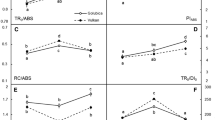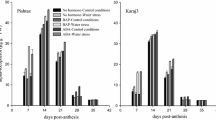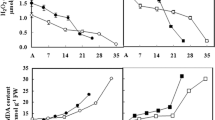Abstract
Yield gains in wheat are a result of greater plant photosynthetic efficiency and better ability to tolerate biotic or abiotic stresses due to the protection of photosynthetic structures from reactive oxygen species (ROS) by efficient antioxidative system. The slower rate of senescence could be associated to higher grain yield. The objective of this study was to identify antioxidative signalling in two different winter wheat varieties which regulates the process of senescence. Concentration of malondialdehyde (MDA) and hydrogen peroxide (H2O2) content, activities of the antioxidant enzymes (catalase (CAT; EC 1.11.1.6), ascorbate peroxidase (APX; EC 1.11.1.11), guaiacol peroxidase (GPOD; EC 1.11.1.7) and polyphenol oxidase (PPO; EC 1.14.18.1)), chlorophyll (Chl) and carotenoid (Car) concentration as well as photosynthetic efficiency in the flag leaves were determined. Results showed that compared to high-quality variety (Olimpija), Kraljica (high-yielding variety) increased CAT, APX, GPOD and PPO activities earlier during the course time experiment, which could be the reason of delayed senescence process. Oxidative damage resulting from increased H2O2 accumulation with increased lipid peroxidation and a decline in antioxidative enzymes activity may contribute to accelerated senescence in Olimpija. Furthermore, delay in senescence in Kraljica was associated with a decrease in the grain protein content. As a result of declination in Chl a + b and carotenoid content, MDA concentration in the flag leaves of Olimpija gradually increased at each sampling point with decline in antioxidant enzymes activity. However, the rate of protein and chlorophyll degradation occurs normally below the green tissue where Kraljica maintained higher chlorophyll level longer then Olimpija.






Similar content being viewed by others
References
Aebi H (1984) Catalase in vitro. Method Enzymol 105:121–126
Ashrafuzzaman M, Islam MR, Ismail MR, Shahidullah SM, Hanafi MM (2009) Evaluation of six aromatic rice varieties for yield and yield contributing characters. Int J Agric Biol 11:616–620
Bahar B (2015) Relationships among flag leaf chlorophyll content, agronomical traits, and some physiological traits of winter wheat genotypes. Dicle University Institute Natural Appl Sci J 4:1–5
Bieker S, Riester L, Stahl M, Franzaring J, Zentgraf U (2012) Senescence-specific Alteration of Hydrogen Peroxide Levels in Arabidopsis thaliana and Oilseed Rape Spring Variety Brassica napus L. cv. Mozart J Integr Plant Biol 54:540–554
Bradford MM (1976) A rapid and sensitive method for quantification of microgram quantities of protein utilizing the principle of protein-dye binding. Anal Biochem 72:248–254
Buet A, Costa ML, Martinez DE, Guiamet JJ (2019) Chloroplast protein degradation in senescing leaves: Proteases and lytic compartments. Front Plant Sci 10:747
Causin HF, Marchetti CF, Pena LB, Gallego SM, Barneix AJ (2015) Down-regulation of catalase activity contributes to senescence induction in wheat leaves exposed to shading stress. Biol Plant 59:154–162
Chakraborty U, Pradhan B (2012) Drought stress-induced oxidative stress and antioxidative responses in four wheat (Triticum aestivum L.) varieties. Arch Agron Soil Sci 58(6):617–630
Chen LO, Lo H, Chen T, Lee L (1992) Peroxidase zymograms of sweet potato (Ipomea batatas (L.) Lam) grown under hydroponic culture. Bot Bull Acad Sinica 33:247–252
Chen JB, Liang Y, Hu XY, Wang XX, Tan FQ, Zhang HQ, Ren ZL, Luo PG (2010) Physiological characterization of ‘stay green’ wheat cultivars during the grain filling stage under field growing conditions. Acta Physiol Plant 32:875–882
Foyer CH, Noctor G (2005) Oxidant and antioxidant signalling in plants: A re-evaluation of the concept of oxidative stress in a physiological context. Plant Cell Environ 28:1056–1071
Gan S, Amasino RM (1997) Making sense of senescence–Molecular genetic regulation and manipulation of leaf senescence. Plant Physiol 113:313–319
Gill SS, Tuteja N (2010) Reactive oxygen species and antioxidant machinery in abiotic stress tolerance in crop plants. Plant Physiol Biochem 48:909–930
Gregersen PL, Culetic A, Boschian L, Krupinska K (2013) Plant senescence and crop productivity. Plant Mol Biol 82:603–622
Hollman PC, Katan MB (1999) Dietary flavonoids; intake, health effects and bioavailability. Food Chem Toxicol 37:937–942
Hortensteiner S, Feller U (2002) Nitrogen Metabolism and Remobilization during Senescence. J Exp Bot 53:927–937
Hortensteiner S, Krautler B (2011) Chlorophyll breakdown in higher plants. Biochem Biophys Acta 1807:977–988
Hui Z, Tian F-X, Wang G, Wang G-P, Wang W (2012) The antioxidative defense system is involved in the delaed senescence in a wheat mutant tasg1. Plant Cell Rep 31:1073–1084
Islam F, Yasmeen T, Ali S, Ali B, Farooq MA, Gill RA (2015) Priming-induced antioxidative responses in two wheat cultivars under saline stress. Acta Physiol Plant 37:153
Jajic I, Sarna T, Strzalka K (2015) Senescence, Stress, and Reactive Oxygen Species. Plants (Basel) 4:393–411
Jukanti AK, Fischer AM (2008) A high-grain protein content locus on barley (Hordeum vulgare) chromosome 6 is associated with increased flag leaf proteolysis and nitrogen remobilization. Physiol Plant 132:426–439
Kamal NM, Gorafi YSA, Abdelrahman M, Abdellatef E, Tsujimoto H (2019) Stay-Green Trait: A Prospective Approach for Yield Potential, and Drought and Heat Stress Adaptation in Globally Important Cereals. Int J Mol Sci 20:5837
Kong L, Sun M, Xie Y, Wang F, Zhao Z (2015) Photochemical and antioxidative responses of the glume and flag leaf to seasonal senescence in wheat. Front Plant Sci 6:358
Kusaba M, Tanaka A, Tanaka R (2013) Stay-green plants: What do they tell us about the molecular mechanism of leaf senescence. Photosynth Res 117:221–234
Lichtenthaler HK (1987) Chlorophylls and carotenoids: pigments of photosynthetic biomembranes. Methods Enzymol 148:350–382
Liu X, Huang B (2000) Heat stress injury in relation to membrane lipid peroxidation in creeping bentgrass. Crop Sci 40:503–510
Lu C, Zhang J (1998) Modifications in photosystem II photochemistry in senescent leaves of maize plants. J Exp Bot 49:1671–1679
Lu QT, Lu CM, Zhang JH, Kuang TY (2002) Photosynthesis and chlorophyll a fluorescence during fl ag leaf senescence of field-grown wheat plants. J Plant Physiol 159:1173–1178
Murchie E, Yang J, Hubbart S, Horton P, Peng S (2002) Are there association between grain-filling rate and photosynhesis in the flag leaves of field-grown rice? J Exp Bot 53:2217–2224
Nakano Y, Asada K (1981) Hydrogen peroxide is scavenged by ascorbate specific peroxidase in spinach chloroplasts. Plant Cell Physiol 22:867–880
Neill S, Desikan R, Hancock J (2002) Hydrogen peroxide signalling. Curr Opin Plant Biol 5:388–395
Patra HK, Kar M, Mishra D (1978) Catalase activity in leaves and cotyledons during plant development and senescence. Biochemie und Physiologie der Pflanzen 172:385–390
Prochazkova D, Sairam RK, Srivastava GC, Singh DV (2001) Oxidative stress and antioxidant activity as the basis of senescence in maize leaves. Plant Sci 161:765–771
Prochazkova D, Wilhelmova N (2007) Leaf senescence and activities of the antioxidant enzymes. Biol plantarum 51:401–406
Raymond J, Rakariyatham N, Azanza J (1993) Purification and some properties of polyphenoloxidase from sunflower seeds. Phytochemistry 34:927–931
Reynolds M, Foulkes MJ, Slafer GA, Berry P, Parry MAJ, Snape JW, Angus WJ (2009) Raising yield potential in wheat. J Exp Bot 60:1899–1918
Siegel BZ, Galston W (1967) The isoperoxidases of Pisum sativum. Plant Physiol 42:221–226
Singleton VL, Rossi JA (1965) Colorimetry of total phenolics with phosphomolybdic–phosphotungstic acid reagents. Am J Enol Vitic 16:144–158
Sorahinobar M, Soltanloo H, Niknam V, Ebrahimzadeh H, Moradi B, Safaie N, Behmanesh M, Bahram M (2017) Physiological and molecular response of resistant and susceptible wheat cultivars to Fusarium graminearum mycotoxin extract. Can J Plant Pathol 39(4):444–453
Strasser RJ, Srivastava A, Tsimilli-Michael M (2004) Analysis of chlorophilla fluorescence transient. In: Papageorgiou GC, Govindjee (eds.) Chlorophyll a fluorescence a signature of photosynthesis: Advances in photosynthesis and respiration. Kluwer Academic Publishers, The Netherlands, 19:321–362
Sylvester-Bradley R, Scott RK, Wright CE (1990) Physiology in the production and improvement of cereals. Home-Grown Cereals Authority, Research Review No 18:156
Thomas H, Ougham H (2014) The stay-green trait. J Exp Bot 65:3889–3900
Uauy C, Distelfeld A, Fahima T, Blechl A, Dubcovsky J (2006) A NAC Gene regulating senescence improves grain protein, zinc, and iron content in wheat. Science 314:1298–1301
Velikova V, Yordanov I, Edreva A (2000) Oxidative stress and some antioxidant systems in acid rain-treated bean plants: protective role of exogenous polyamines. Plant Sci 151:59–66
Verma S, Dubey RS (2003) Leads toxicity induces lipid peroxidation and alters the activities of antioxidant enzymes in growing rice plants. Plant Sci 164:645–655
Viljevac Vuletić M, Španić V (2020) Characterization of photosynthetic performance during natural leaf senescence in winter wheat: Multivariate analysis as a tool for phenotypic characterization. Photosynthetica 58(2):301–313
Wada Y, Miura K, Watanabe K (1993) Effects of source to sink ratio on carbohydrate production and senescence of rice flag leaves during the ripening period. Jpn J Crop Sci 62:547–553
Yarmolinskyet D, Brychkova G, Kurmanbayeva A, Bekturova A, Ventura Y, Khozin-Goldberg I, Eppel A, Fluhr R, Sagi M (2014) Impairment in sulfite reductase leads to early leaf senescence in tomato plants. Plant Physiol 165:1505–1520
Zhang CJ, Chen GX, Gao XX, Chu CJ (2006) Photosynthetic decline in flag leaves of two field-grown spring wheat cultivars with different senescence properties. S Afr J Bot 72:15–23
Zimmermann P, Heinlein C, Orendi G, Zentgraf U (2006) Senescence-specific regulation of catalases in Arabidopsis thaliana (L.) heynh. Plant Cell Environ 29:1049–1060
Acknowledgements
We would like to acknowledge Dr. Tihana Marcek for her help during the assessment of antioxidant activities and components. This work has been supported in part by Croatian Science Foundation (HRZZ-UIP-2014-9188).
Author information
Authors and Affiliations
Corresponding author
Ethics declarations
Conflict of interest
The authors declare that they have no conflicts of interest with the contents of this article.
Additional information
Communicated by P. Wojtaszek.
Publisher's Note
Springer Nature remains neutral with regard to jurisdictional claims in published maps and institutional affiliations.
Rights and permissions
About this article
Cite this article
Spanic, V., Zdunic, Z. & Viljevac Vuletic, M. Comparative changes in the physiological traits in the flag leaf of two senescing varieties of wheat (Triticum aestivum L.). Acta Physiol Plant 42, 108 (2020). https://doi.org/10.1007/s11738-020-03096-y
Received:
Revised:
Accepted:
Published:
DOI: https://doi.org/10.1007/s11738-020-03096-y




